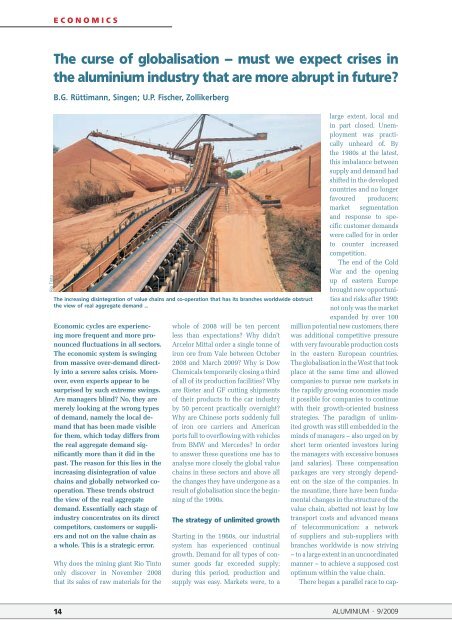special - Alu-web.de
special - Alu-web.de
special - Alu-web.de
You also want an ePaper? Increase the reach of your titles
YUMPU automatically turns print PDFs into web optimized ePapers that Google loves.
Rio Tinto e c o n o m i c s<br />
The curse of globalisation – must we expect crises in<br />
the aluminium industry that are more abrupt in future?<br />
B.G. Rüttimann, Singen; U.P. Fischer, Zollikerberg<br />
The increasing disintegration of value chains and co-operation that has its branches worldwi<strong>de</strong> obstruct<br />
the view of real aggregate <strong>de</strong>mand …<br />
Economic cycles are experiencing<br />
more frequent and more pronounced<br />
fluctuations in all sectors.<br />
The economic system is swinging<br />
from massive over-<strong>de</strong>mand directly<br />
into a severe sales crisis. Moreover,<br />
even experts appear to be<br />
surprised by such extreme swings.<br />
Are managers blind? No, they are<br />
merely looking at the wrong types<br />
of <strong>de</strong>mand, namely the local <strong>de</strong>mand<br />
that has been ma<strong>de</strong> visible<br />
for them, which today differs from<br />
the real aggregate <strong>de</strong>mand significantly<br />
more than it did in the<br />
past. The reason for this lies in the<br />
increasing disintegration of value<br />
chains and globally networked cooperation.<br />
These trends obstruct<br />
the view of the real aggregate<br />
<strong>de</strong>mand. Essentially each stage of<br />
industry concentrates on its direct<br />
competitors, customers or suppliers<br />
and not on the value chain as<br />
a whole. This is a strategic error.<br />
Why does the mining giant Rio Tinto<br />
only discover in November 2008<br />
that its sales of raw materials for the<br />
whole of 2008 will be ten percent<br />
less than expectations? Why didn’t<br />
Arcelor Mittal or<strong>de</strong>r a single tonne of<br />
iron ore from Vale between October<br />
2008 and March 2009? Why is Dow<br />
Chemicals temporarily closing a third<br />
of all of its production facilities? Why<br />
are Rieter and GF cutting shipments<br />
of their products to the car industry<br />
by 50 percent practically overnight?<br />
Why are Chinese ports sud<strong>de</strong>nly full<br />
of iron ore carriers and American<br />
ports full to overflowing with vehicles<br />
from BMW and Merce<strong>de</strong>s? In or<strong>de</strong>r<br />
to answer these questions one has to<br />
analyse more closely the global value<br />
chains in these sectors and above all<br />
the changes they have un<strong>de</strong>rgone as a<br />
result of globalisation since the beginning<br />
of the 1990s.<br />
The strategy of unlimited growth<br />
Starting in the 1960s, our industrial<br />
system has experienced continual<br />
growth. Demand for all types of consumer<br />
goods far excee<strong>de</strong>d supply;<br />
during this period, production and<br />
supply was easy. Markets were, to a<br />
large extent, local and<br />
in part closed. Unemployment<br />
was practically<br />
unheard of. By<br />
the 1980s at the latest,<br />
this imbalance between<br />
supply and <strong>de</strong>mand had<br />
shifted in the <strong>de</strong>veloped<br />
countries and no longer<br />
favoured producers;<br />
market segmentation<br />
and response to specific<br />
customer <strong>de</strong>mands<br />
were called for in or<strong>de</strong>r<br />
to counter increased<br />
competition.<br />
The end of the Cold<br />
War and the opening<br />
up of eastern Europe<br />
brought new opportunities<br />
and risks after 1990:<br />
not only was the market<br />
expan<strong>de</strong>d by over 100<br />
million potential new customers, there<br />
was additional competitive pressure<br />
with very favourable production costs<br />
in the eastern European countries.<br />
The globalisation in the West that took<br />
place at the same time and allowed<br />
companies to pursue new markets in<br />
the rapidly growing economies ma<strong>de</strong><br />
it possible for companies to continue<br />
with their growth-oriented business<br />
strategies. The paradigm of unlimited<br />
growth was still embed<strong>de</strong>d in the<br />
minds of managers – also urged on by<br />
short term oriented investors luring<br />
the managers with excessive bonuses<br />
(and salaries). These compensation<br />
packages are very strongly <strong>de</strong>pen<strong>de</strong>nt<br />
on the size of the companies. In<br />
the meantime, there have been fundamental<br />
changes in the structure of the<br />
value chain, abetted not least by low<br />
transport costs and advanced means<br />
of telecommunication: a network<br />
of suppliers and sub-suppliers with<br />
branches worldwi<strong>de</strong> is now striving<br />
– to a large extent in an uncoordinated<br />
manner – to achieve a supposed cost<br />
optimum within the value chain.<br />
There began a parallel race to cap-<br />
14 ALUMINIUM · 9/2009
















